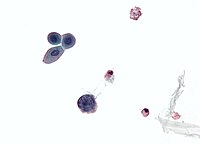
Photo from wikipedia
Since it was clearly established that HIV/AIDS predisposes to the infection, persistence or reactivation of latent viruses, the prevalence of human polyomaviruses (HPyVs) among HIV-1-infected patients and a possible correlation… Click to show full abstract
Since it was clearly established that HIV/AIDS predisposes to the infection, persistence or reactivation of latent viruses, the prevalence of human polyomaviruses (HPyVs) among HIV-1-infected patients and a possible correlation between HPyVs and HIV sero-status were investigated. PCR was performed to detect and quantify JCPyV, BKPyV, MCPyV, HPyV6, HPyV7 and QPyV DNA in the urine and plasma samples of 103 HIV-1-infected patients. Subsequently, NCCR, VP1 and MCPyV LT sequences were examined. In addition, for MCPyV, the expression of transcripts for the LT gene was investigated. JCPyV, BKPyV and MCPyV’s presence was reported, whereas HPyV6, HPyV7 and QPyV were not detected in any sample. Co-infection patterns of JCPyV, BKPyV and MCPyV were found. Archetype-like NCCRs were observed with some point mutations in plasma samples positive for JCPyV and BKPyV. The VP1 region was found to be highly conserved among these subjects. LT did not show mutations causing stop codons, and LT transcripts were expressed in MCPyV positive samples. A significant correlation between HPyVs’ detection and a low level of CD4+ was reported. In conclusion, HPyV6, HPyV7 and QPyV seem to not have a clinical relevance in HIV-1 patients, whereas further studies are warranted to define the clinical importance of JCPyV, BKPyV and MCPyV DNA detection in these subjects.
Journal Title: Viruses
Year Published: 2022
Link to full text (if available)
Share on Social Media: Sign Up to like & get
recommendations!